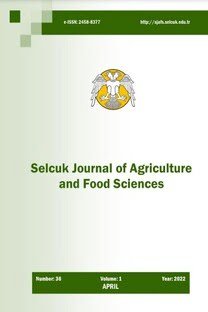Bazı gübrelerin Trichoderma harzianum' un misel gelişimi ve spor üretimine etkisi
Günümüzde patojen mikroorganizmaları ortadan kaldırmada pestisidler ve organik kimyasallar zor parçalandığı, bitki ve hayvanlarda depolanarak besin zinciri yolu ile canlılara toksik etki yaptığı için son yıllarda biyolojik mücadelenin önemi artmıştır. Biyolojik mücadele etmeni olarak çeşitli mikroorganizmalar kullanılmaktadır. Trichoderma spp 'de bu amaçla kullanılan funguslardan biridir. Bu çalışmada, farklı gübrelerin Trichoderma harzianum izolatlarının spor üretimi ve misel gelişimine etkileri in vitro'da incelenmiştir. En düşük koloni çapı T7 izolatı ile üre içeren ortamda alınmıştır. T7 izolatını, T14 izolatı izlemiştir. T. harzianum izolatlarının kuru misel ağırlıklarında farklılıklar oluşmuş, besi ortamlarına verilen gübreler spor sayılarını arttırmıştır. En fazla spor üretimi üre (60 mg/l), amonyum sülfat ve üre + triple süper fosfatta bulunmuştur.
Anahtar Kelimeler:
ticari gübreler, Trichoderma harzianum, misel, spor
Effects of some fertilizers on mycelial growth and spore production of Trichoderma harzianum
Nowadays, pestisides and organic compounds are being widely used to inhibit pathogen microorganisms. Degradation of these compounds are very difficult and accumulation and concentration of them in food chains leading to toxicity in animals at higher tropic level. As a result, biological control has become increasingly important in recent years. It is showed that Trichoderma spp. could be used as a biocontrol agent. In this study, spore production and mycelial growth of Trichoderma harzianum isolates were studied in vitro. The lowest colony diameter was obtained from isolate T7 in urea. It was followed by TI4. Differences in dry weight of mycelial growth ofT. harzianum were observed between the isolates and addition of fertilizers to the media increased numbers of spores. Addition of fertilizers to the media increased number of spore. There was maximum spore production in urea, ammonium sulphate and urea + triple superphosphate.
Keywords:
fertilizers, Trichoderma harzianum, micelles, spores,
___
- Altamore, C., Norwell, W.A., Bjorkman, T., Harman, G.E. 1999. Solubilization of phosphates and micronutrients by the plant growth promoting and biocontrol fungus T. harzianum Rifai 1295-22. Applied and Environmental Microbiol. 65, 2926- 2933.
- Anke,T. 1997. Fungal Biotecnology, Chapman and Hall, London, pp. 65-76.
- Basım, H., Öztürk, Ş.B., Yeğen, O. 1999. Biyolojik bir fungisid (Planter Box T. harzianum Rifaii T- 22)’in pamuk fide kök çürüklüğü etmenlerine (Rhizoctonia solani, Fusarium spp.) karşı etkinliğinin araştırılması. GAP I. Tarım Kongresi, Şanlıurfa, s. 137-144
- Beagle-Ristaino, J.E., Papavizas, G.C. 1985. Survival and proliferation of propagules of Trichoderma spp. and Gliocladium virens in soil and plant rhizospheres. Phytopathology. 75, 729-732.
- Blakeman, J. P. 1978. Microbial competition for nutrients and germination of fungal spores. Ann. Appl. Biol. 89, 151-155.
- Boland, G.J. 1990. Biological control of plant diseases with fungal antagonists: Challanges and opportunities. Can J Plant Pathology 12, 295-299.
- Celar, F. 2000. Competition for ammonium and nitrate forms of nitrogen between some phytopathogenic and antagonistic soil fungi. Biological Control.121, 350-356.
- Ghisalberti, E.L., Sivasithamparam, K. 1991. Antifungal Antibioticss produced by Trichoderma spp. Soil biol. Biochem. 23(11), 1011-1020.
- Inbar, J., Abramsky, D.C., Chet, I. 1994. Plant growth enhancement and disease control by Trichoderma harzianum in vegetable seedling grown under commercial conditions. Plant pathology. 100, 337-346.
- Kınacı, E. 2000. Orta Anadolu’da Tahıl Tarımı, Türkiye Ziraat Odaları Birliği, 68 s. Ankara
- Küçük, Ç., Kıvanç, M. 2003. Isolation of Trichoderma spp. from Turkey Soil and Determination of Their Antifungal Features. Turk J Biol. 27, 247-253.
- Schirmböck, M., Lorito, M., Wang, Y.L., Hayes, C.K., Arslan-Atac, I., Scala, F., Harman, G.E., Kubicek, C.P. 1994. Parallel formation and synergism of hydrolytic enzymes and peptaibol antibiotics, molecular mechanisms involved in the antagonist action of T. harzianum against phytopathogenic fungi. Appl Environ Microbiol 60, 4364-4370.
- Sivan A., Chet, I. 1989. The possible role of competition between Trichoderma harzianum and Fusarium oxysporum on rhizosphere colonization. Phytopathology.79, 108-203.
- Wartanabe, N., Lewis, J.A., Papavizas, G.C., 1987. Influence of nitrogen fertilizers on growth, spore production and germination and biological potential of Trichoderma and Gliocladium. J. Phytopathol.120, 337-346.
- Whipps, J.M., Davies, K.G. 2000. Biocontrol of plant pathogens and nematods by microorganisms. In: Gurr G., Wratten, SD (eds). Measures of success in biological control. Kluwer, Dordrecht, pp 231-269.
- Yedidia, I., Benhamou, N., Kapulnik, Y., Chet, I. 2000. Induction and accumilation of PR proteins activity during early stages of root colonization by the mycoparasite Trichoderma harzianum strain T203. Plant Physiol. Biochem. 38, 863-873
- Yurtsever,N. 1984. Deneysel istatistik metodları. Tarım Orman Köy Hizmetleri Genel Müdürlüğü Yayın No:121, 623s. Ankara.
- ISSN: 1300-5774
- Yayın Aralığı: Yılda 3 Sayı
- Başlangıç: 2018
- Yayıncı: Selçuk Üniv. Ziraat Fak.
Sayıdaki Diğer Makaleler
Bitki gelişiminde fosfat çözücü bakterilerin önemi
Bor uygulamasının nohut (Cicer arietinum L.) çeşitlerinde verim ve bazı verim unsurlarına etkileri
Hakan BAYRAK, MUSTAFA ÖNDER, Sait GEZGİN
Sarımsak dişlerinin vakumla tutulmasına etkili bazı parametrelerin belirlenmesi
Some physical properties of mash bean (Phaseolus aureus L.) seeds cultivated in Turkey
Bitkilerin hastalıklara karşı dayanıklılığında konukçu enzimlerin rolü
TAMER MARAKOĞLU, Mustafa KONAK
Türkiye' de üretilen bazı meyve suyu ve konsantresinde patulin miktarının HPLC ile belirlenmesi
